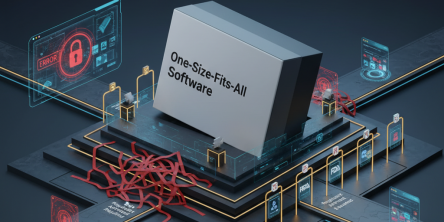Qlik vs Power BI: Which Analytics Platform Wins in 2025?

In today’s data-driven world, choosing the right business intelligence (BI) platform can make or break your organization's analytics success. Among the top contenders in the field are Qlik and Power BI, two powerful analytics platforms widely adopted across industries globally. As we approach 2025, businesses evaluating their options face a critical choice between Qlik vs Power BI. This blog explores key differences, strengths, and weaknesses of both platforms to help you decide which analytics solution will best suit your needs this year.
Overview of Qlik and Power BI
Qlik offers a well-established suite of data analytics tools, most notably Qlik Sense, known for its associative data engine that allows users to explore data relationships intuitively. It emphasizes business user empowerment with self-service analytics and visually compelling dashboards.
Power BI, developed by Microsoft, is deeply integrated into the Microsoft ecosystem, supporting seamless connectivity to a vast array of data sources including Excel, Azure, and Dynamics 365. It stands out for its ease of use, cost-effectiveness, and continuous feature enhancements driven by Microsoft’s robust development pipeline.
Key Comparison Factors in Qlik vs Power BI
1. Data Integration and Connectivity
Power BI supports over 500 data connectors natively, spanning cloud platforms, databases, and enterprise apps. Its integration within Microsoft products enhances productivity for Microsoft-centric environments. Qlik also supports a vast range of connections but is particularly strong in handling complex, multi-source data models with its in-memory associative engine, which excels at uncovering hidden data associations.
2. Usability and Learning Curve
Power BI is often praised for its intuitive and user-friendly interface, allowing business users and analysts with basic technical skills to create insightful reports rapidly. Qlik Sense provides rich customization and analytics capabilities but requires more initial user training to unlock its full power, especially for advanced data modeling.
3. Advanced Analytics and AI Features
Both platforms offer AI-driven analytics; Power BI integrates Microsoft’s AI tools such as Azure Cognitive Services and machine learning models directly into its reports and dashboards. Qlik has similarly invested in AI and augmented analytics through Qlik Insight Bot and advanced cognitive services, focusing on natural language querying and predictive analytics.
4. Pricing and Deployment Models
Power BI offers attractive pricing tiers with a strong free community version and competitive monthly subscriptions for Pro and Premium tiers, making it cost-effective for SMBs and enterprises. Qlik is generally positioned as a premium solution with pricing tailored to enterprise customers, which can be higher but includes flexible deployment options including cloud, on-premises, and hybrid.
5. Performance and Scalability
Qlik’s associative model provides excellent performance for large, complex data sets and dynamic calculations, favored in environments with complicated analytical needs. Power BI’s performance has significantly improved with its enhanced dataset handling and aggregation features, supporting enterprise scalability through Premium capacities.
6. Community and Ecosystem
Power BI benefits from Microsoft’s vast user community, extensive documentation, and integration with Azure services and Microsoft Power Platform tools. Qlik has a passionate, specialized user base and provides strong support channels but is less widespread than Power BI.
Practical Use Cases
Businesses heavily invested in Microsoft tech stacks and seeking quick deployment and ease of use often prefer Power BI.
Organizations with complex data relationships and advanced analytics needs that require deep associative exploration lean toward Qlik.
Companies prioritizing cost efficiency and rapid adoption tend to favor Power BI.
Enterprises requiring flexible deployment (cloud or on-premises) and advanced, customizable data exploration prefer Qlik.
Conclusion: Which Analytics Platform Wins in 2025?
Selecting between Qlik vs Power BI in 2025 hinges on your organization’s specific needs, technical expertise, and budget. Power BI shines in accessibility, integration, and affordability, making it an excellent choice for organizations prioritizing user-friendly analytics within the Microsoft ecosystem. Qlik’s strengths lie in robust data modeling, associative exploration, and flexibility, suiting enterprises with complex data environments and the resources to maximize its capabilities.
Both platforms continue to evolve rapidly with AI integration and improved performance, so it’s wise to evaluate recent updates and try demos or trials to make the best-informed decision.
By weighing these factors—cost, ease of use, data complexity, and scalability—you can confidently choose the analytics platform that will empower your business intelligence journey in 2025 and beyond.
This comprehensive look at Qlik vs Power BI ensures you are equipped with the insights necessary to select the right tool for turning data into a competitive advantage.
Similar Articles
Not long ago, the idea of multiple AI agents working together, each with a specific role, collaborating to solve problems, felt like science fiction.
We all know that companies today are no longer limited to a single physical location. Work processes are also no longer strictly isolated.
It is neither secret nor news that the mind-boggling pace of digital transformation around us has totally altered consumer expectations.
In the world of finance, speed and accuracy are everything. Decisions made a day late can cost millions, and delayed visibility into financial performance can leave even the best organizations blind to risks.
Discover the best tools to enhance employee recognition, boost morale, and create a more motivated, engaged workplace culture.
At first glance, off-the-shelf software appears to be a dream come true. They are quick to set up, cheaper upfront, and marketed as “universal.”
A modern business must continually adapt. This bit everyone seems to know.
The modern healthcare industry is undergoing a significant transformation. The models of healthcare that we are used to thus far are now making way for a more data driven approach
In the modern world, maintaining good health often feels like a constant challenge. Between busy lifestyles, sedentary habits, and lack of motivation, many people find it difficult to stay consistent with exercise, diet, or wellness practices.









